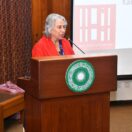By Nasir Iqbal
Published in pide.org.pk Publication Year : 2025
Last week, sensational headlines rattled Pakistan’s development discourse: poverty has surged, nearly half the population is now classified as poor, and extreme poverty has tripled. According to the World Bank’s revised estimates, poverty under the $4.20 per day line has jumped from 39.8% to 44.7%, while extreme poverty, measured at $3 per day, has soared from 4.9% to 16.5%. The dominant narrative quickly crystallized — poverty is rising sharply because policies have failed.
But let’s take a step back. This narrative, while emotionally resonant, is dangerously misleading. It risks triggering policy panic at a time when thoughtful, evidence-based reflection is needed. These new figures do not reflect a sudden collapse of Pakistan’s socioeconomic fabric. Rather, they point to a different reality — one rooted in methodological recalibration, not mass impoverishment.
The sharp uptick in poverty rates is largely the result of the World Bank’s upward revision of global poverty lines. For lower-middle-income countries like Pakistan, the general poverty threshold has been increased from $3.20 to $4.20 per day. Likewise, the extreme poverty line has been revised upward from $2.15 to $3 per day. These changes represent a substantial recalibration of the baseline used to assess poverty. When the bar is raised, more people fall below it — not because their lives have deteriorated, but because the measurement standard has shifted.
According to disaggregated estimates, a staggering 82% of the reported increase in poverty stems directly from the revision in poverty lines. The remaining 18% is attributable to domestic price inflation between 2017 and 2021 — a real concern, along with COVID-19, but not a sign of systemic collapse. It is essential to separate the signal from the noise — a methodological shift from actual declines in material well-being.
The story becomes even more nuanced. The World Bank’s latest poverty analysis relies on 2018–19 Household Integrated Economic Survey (HIES) data and outdated population projections, overlooking critical developments since then. It disregards the 2023 population census and more recent policy innovations such as the Ehsaas Program, the Ultra-Poor Graduation initiatives, and most notably, the large-scale expansion of the Benazir Income Support Program (BISP).
These measures, while not flawless, have played a significant role in mitigating extreme poverty. Equally important is what the report omits — the resilience of Pakistan’s vast informal economy and deeply rooted community support systems that often act as informal safety nets in times of hardship. Equally significant are the steady inflows of remittances from overseas Pakistanis, which have consistently cushioned household consumption, supported domestic demand, and prevented deeper poverty during times of economic stress. In effect, the World Bank’s portrayal is incomplete — if not skewed — offering a snapshot that underrepresents the full spectrum of socioeconomic dynamics at play.
Compare this to historical trends. Between 2005–06 and 2018–19, Pakistan’s poverty rate dropped from 50.4% to 22.5% — a substantial decline observed across both urban and rural populations. What’s remarkable is that this progress unfolded despite sluggish GDP growth, political turbulence, and recurring shocks ranging from natural disasters to global financial crises. The poverty reduction was not accidental; it reflected structural changes — including improved access to education, enhanced rural-urban connectivity, and the growing footprint of the informal sector, which continued to provide income opportunities even as formal employment faltered.
Take just one transformation: the expansion of Pakistan’s urban economy. Rising internal migration, a construction boom, and increased consumption all illustrate the underlying mechanics of basic economic resilience. These dynamics reveal that, despite weaknesses in the formal economy, informal sectors have absorbed shocks and driven progress. If the informal economy were fully captured in GDP statistics, Pakistan might already qualify as a high middle-income country.
That said, we acknowledge that the pace of poverty reduction has recently stalled — not reversed — due to a confluence of economic and environmental shocks. The COVID-19 pandemic, devastating floods, and ongoing macroeconomic instability have slowed progress, but there is no compelling evidence of an extraordinary poverty surge.
My estimates for 2025 — grounded in updated national data and local realities — suggest that the current poverty rate lies between 23% and 25%, broadly consistent with the long-term trend of gradual improvement (see Table below). Meanwhile, food expenditure-based indicators place poverty at just 6.2%, reaffirming that the narrative of mass impoverishment is not supported by the evidence.
So where is the crisis? If anything, this is a moment for nuance, not noise. But nuance rarely makes headlines.
Herein lies the risk: if we accept these revised poverty numbers at face value and frame them as a sweeping policy failure, we risk misdirecting public debate and policy choices. Pressure could mount for indiscriminate, populist handouts instead of scaling up smarter, evidence-based approaches. Worse still, we could erode public trust in the very policies and institutions that have underpinned steady poverty reduction over the past two decades.
A single headline-grabbing statistic, if taken out of context, can reshape national priorities overnight. But policymaking must rise above sensationalism. Pakistan needs clarity, not chaos.
We are not denying that poverty remains a serious concern. Nor are we blind to the distress caused by inflation, limited access to quality education, and fragile employment conditions. But if we are to fight poverty effectively, we must distinguish between statistical recalibrations and actual changes in material wellbeing.
This moment should be seen as a policy wake-up call—not a panic button. It invites us to revisit our frameworks, refresh our data systems, and, above all, recalibrate our understanding of poverty considering both global benchmarks and local contexts. A crucial first step must be the urgent resumption of the HIES, which was paused during the 2023 Census. Without updated and credible household-level data, policy design will continue to fly blind. Evidence-based policymaking is impossible without a timely understanding of the ground reality.
But we must not stop there. First, Pakistan needs a comprehensive National Poverty Reduction Strategy—an integrated blueprint that aligns social protection with economic development, productivity gains, and Sustainable Development Goals (SDGs). Piecemeal and reactive approaches must be replaced with a forward-looking, systems-based model.
Second, instead of ballooning unconditional cash transfers to 9 million households under the BISP without a transparent needs reassessment or graduation strategy, we need a results-based framework that links support to empowerment outcomes—education, health, asset accumulation, and labor force participation. Spending over PKR 700 billion on cash transfers without clarity on outcomes risks inefficiency and long-term dependency.
Third, the government must empower national think tanks—like PIDE—to regularly generate independent poverty estimates and actionable research. This will ensure a robust local knowledge base, reduce dependency on external analyses, and cultivate informed public discourse.
Fourth, it is time to abandon the false dichotomy between social protection and economic dynamism. The informal sector—home to over 60% of Pakistan’s labor force—is not a problem to be regulated away, but a potential driver of inclusive growth. We must formalize productivity, not paperwork. This is where Village Economic Zones (VEZs) come in. These zones, if integrated with local value chains, digital infrastructure, and CPEC’s rural components (especially in agriculture and agri-tech), could transform informal livelihoods into scalable enterprises. VEZs can help boost productivity, generate rural employment, and create economic resilience without the need for blanket subsidies.
Finally, poverty cannot be eliminated through charity alone—it must be tackled through dignity and opportunity. That means investing in quality education, facilitating private sector-led job creation, and abolishing bureaucratic hurdles that stifle entrepreneurship. The state must shift from being a distributor of aid to an enabler of livelihoods.
In short, the government must:
- Resume the HIES immediately to establish reliable poverty baselines.
- Draft a National Poverty Reduction Plan aligned with SDGs and economic transformation goals.
- Reform the BISP to link cash transfers with empowerment metrics.
- Support research institutions like PIDE to generate independent and context-sensitive data.
- Prioritize informal sector productivity through VEZs, rural market integration, and support for micro-enterprises.
- Shift fiscal priorities from blanket subsidies to strategic investments in human capital, technology, and enterprise development.
Pakistan must stay the course—rationally, courageously, and innovatively. The country’s development journey cannot be hijacked by poorly interpreted metrics. Instead, let us use this moment of uncertainty to build a smarter, more inclusive economic future. The illusion of poverty may dominate today’s headlines—but the reality of possibility should define tomorrow’s policy.
Table: Poverty Trend: Projections
| Year | FEI based Poverty | CBN Based Poverty | ||||
| National | Urban | Rural | National | Urban | Rural | |
| FY19 | 5.4 | 1.9 | 7.3 | 21.6 | 10.7 | 27.9 |
| FY20 | 7.2 | 3.8 | 9.2 | 24.3 | 13.4 | 30.5 |
| FY21 | 4.8 | 1.3 | 6.7 | 20.8 | 9.9 | 27.0 |
| FY22 | 4.9 | 1.5 | 6.9 | 21.0 | 10.1 | 27.3 |
| FY23 | 8.4 | 5.0 | 10.4 | 26.0 | 15.1 | 32.2 |
| FY24 | 7.4 | 4.0 | 9.3 | 24.5 | 13.6 | 30.7 |
| FY25 | 6.2 | 2.8 | 8.2 | 22.9 | 12.0 | 29.1 |
Source: Author’s projections



